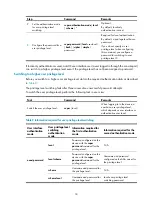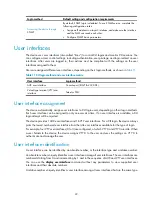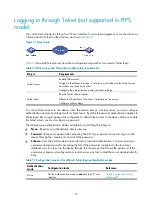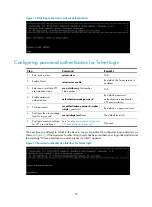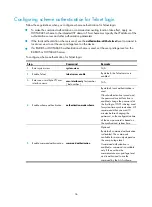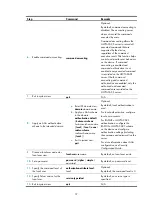
32
Step Command
Remarks
6.
Specify the number of data
bits in a character.
databits
{
7
|
8
}
By default, the number of data bits in
each character is 8.
The setting depends on the character
coding type. For example, you can
set it to 7 if standard ASCII
characters are to be sent, and set it
to 8 if extended ASCII characters
are to be sent.
7.
Define a shortcut key for
starting a terminal session.
activation-key
character
By default, press
Enter
to enable a
terminal session.
8.
Define a shortcut key for
terminating tasks.
escape-key
{
default
|
character
}
By default, pressing
Ctrl+C
terminates a task.
9.
Configure the flow control
mode.
flow-control
{
hardware
|
none
|
software
}
By default, the flow control mode is
none
.
The device supports only the
none
mode.
10.
Specify the terminal display.
terminal type
{
ansi | vt100
}
By default, the terminal display type
is ANSI.
The device supports two terminal
display types: ANSI and VT100. HP
recommends that you set the display
type to VT100 on both the device
and the configuration terminal. If
either side uses the ANSI type, a
display problem such as cursor
positioning error might occur when
a command line has more than 80
characters.
11.
Configure the user privilege
level for login users.
user privilege level
level
By default, the default command
level is 3 for the AUX user interface.
12.
Set the maximum number of
lines to be displayed on a
screen.
screen-length
screen-length
By default, a screen displays 24
lines at most.
A value of 0 disables pausing
between screens of output.
13.
Set the size of command
history buffer.
history-command max-size
value
By default, the buffer saves 10
history commands at most.
14.
Set the idle-timeout timer.
idle-timeout
minutes
[
seconds
]
The default idle-timeout is 10
minutes. The system automatically
terminates the user's connection if
there is no information interaction
between the device and the user
within the idle-timeout time.
Setting idle-timeout to 0 disables the
timer.

